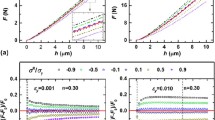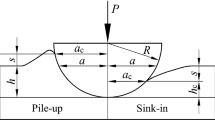Abstract
The finite element simulations show that non-equibiaxial residual stresses (RS) can shift the load-depth curve from the unstressed curve and cause elliptical remnant indentation in spherical indentation. Thus the relative load change between stressed and unstressed samples and the asymmetry of elliptical remnant indentation were employed as characteristic parameters to evaluate the magnitude and directionality of RS. Through theoretical and numerical analysis, the effects of RS on indentation load and remnant impression as well as the affect mechanism were systematically discussed. Finally, two equations which could provide foundations for establishing spherical indentation method to evaluate non-equibiaxial RS were obtained.






Similar content being viewed by others
References
J. Lu: Handbook of Measurement of Residual Stresses (The Fairmont Press, Lilburn, Georgia, 1996).
S. Suresh and A.E. Giannakopoulos: A new method for estimating residual stresses by instrumented sharp indentation. Acta Mater. 46, 5755 (1998).
T.Y. Tsui, W.C. Oliver, and G.M. Pharr: Influences of stress on the measurement of mechanical properties using nanoindentation: Part I. Experimental studies in an aluminum alloy. J. Mater. Res. 11, 752 (1996).
B. Taljat and G.M. Pharr: Measurement of residual stress by load and depth sensing spherical indentation. Mater. Res. Soc. Symp. Proc. 594, 519 (2000).
S. Carlsson and P.-L Larsoon: On the determination of residual stress and strain fields by sharp indentation testing. Part I: Theoretical and numerical analysis. Acta Mater. 49, 2179 (2001).
J.G. Swadener, B. Taljat, and G.M. Pharr: Measurement of residual stress by load and depth sensing indentation with spherical indenters. J. Mater. Res. 16, 2091 (2001).
A.E. Giannakopoulos: The Influence of Initial elastic surface stresses on instrumented sharp indentation. J. Appl. Mech. 70, 638 (2003).
Z.K. Lu, Y.H. Feng, G.J. Peng, R. Yang, Y. Huan, and T.H. Zhang: Estimation of surface equi-biaxial residual stress by using instrumented sharp indentation. Mater. Sci. Eng. A 614, 264 (2014).
L. Xiao, D. Ye, and C. Chen: A further study on representative models for calculating the residual stress based on the instrumented indentation technique. Comput. Mater. Sci. 82, 476 (2014).
M. He, C.H. Huang, X.X. Wang, F. Yang, N. Zhang, and F.G. Li: Assessment of the Local Residual Stresses of 7050-T7452 Aluminum Alloy in microzones by the instrumented indentation with the Berkovich Indenter. J. Mater. Eng. Perform. 26, 4923 (2017).
T.-H. Pham and S.-E. Kim: Determination of equi-biaxial residual stress and plastic properties in structural steel using instrumented indentation. Mater. Sci. Eng. A 688, 352 (2017).
V.P. Fardin, E.A. Bonfante, P.G. Coelho, M.N. Janal, N. Tovar, L. Witek, D. Bordin, and G. Bonfante: Residual stress of porcelain-fused to zirconia 3-unit fixed dental prostheses measured by nanoindentation. Dent. Mater. 34, 260 (2018).
G. Peng, Z. Lu, Y. Ma, Y. Feng, Y. Huan, and T. Zhang: Spherical indentation method for estimating equibiaxial residual stress and elastic-plastic properties of metals simultaneously. J. Mater. Res. 33, 884 (2018).
J. Chen, J. Liu, and C. Sun: Residual stress measurement via digital image correlation and sharp indentation testing. Opt. Eng. 55, 124102 (2016).
Y.-C. Kim, M.-J. Choi, D. Kwon, and J.-Y. Kim: Estimation of principal directions of Bi-axial residual stress using instrumented Knoop indentation testing. Met. Mater. Int. 21, 850 (2015).
F. Rickhey, J.H. Lee, and H. Lee: A contact size-independent approach to the estimation of biaxial residual stresses by Knoop indentation. Mater. Des. 84, 300 (2015).
Y.-H. Lee and D. Kwon: Estimation of biaxial surface stress by instrumented indentation with sharp indenters. Acta Mater. 52, 1555 (2004).
L. Shen, Y. He, D. Liu, Q. Gong, B. Zhang, and J. Lei: A novel method for determining surface residual stress components and their directions in spherical indentation. J. Mater. Res. 30, 1078 (2015).
Y.-C. Kim, H.-J. Ahn, D. Kwon, and J.-Y. Kim: Modeling and experimental verification for non-equibiaxial residual stress evaluated by Knoop indentations. Met. Mater. Int. 22, 12 (2006).
H.-J. Ahn, J.-H. Kim, H. Xu, J. Lee, J.-Y. Kim, Y.-C. Kim, and D. Kwon: Directionality of residual stress evaluated by instrumented indentation testing using wedge indenter. Met. Mater. Int. 23, 465 (2017).
J.H. Han, J.S. Lee, Y.H. Lee, M.J. Choi, G. Lee, K.H. Kim, and D. Kwon: Residual stress estimation with identification of stress directionality using instrumented indentation technique. Key Eng. Mater. 345-346, 1125 (2007).
M.-J. Choi, S.-K. Kang, I. Kang, and D. Kwon: Evaluation of nonequibiax-ial residual stress using Knoop indenter. J. Mater. Res. 27, 121 (2011).
H. Hertz: Miscellaneous Papers (Macmillan, London, 1896).
K.L. Johnson: Contact Mechanics (Cambridge University Press, Cambridge, UK, 1985).
L. Brand: The Pi theorem of dimensional analysis. Arch. Ration. Mech. Anal. 1, 35 (1957).
C. Yu, Y.H. Feng, R. Yang, G.J. Peng, Z.K. Lu, and T.H. Zhang: An integrated method to determine elastic-plastic parameters by instrumented spherical indentation. J. Mater. Res. 29, 1095 (2014).
W.Y. Ni, Y.T. Cheng, C.M. Cheng, and D.S. Grummon: An energy-based method for analyzing instrumented spherical indentation experiments. J. Mater. Res. 19, 149 (2004).
T. Zhang, C. Yu, G. Peng, and Y. Feng: Identification of the elastic-plastic constitutive model for measuring mechanical properties of metals by instrumented spherical indentation test. MRS Commun. 7, 221 (2017).
Acknowledgments
The authors would like to gratefully acknowledge the support from the National Natural Science Foundation of China (Grant Nos. 11727803, 11772302, 11672356, 11402233, and 11502235) and Public Welfare Project of Zhejiang Province (2015C31074).
Author information
Authors and Affiliations
Corresponding author
Supplementary material
Supplementary material
The supplementary material for this article can be found at https://doi.org/10.1557/mrc.2018.240
Rights and permissions
About this article
Cite this article
Zhang, T., Cheng, W., Peng, G. et al. Numerical investigation of spherical indentation on elastic-power-law strain-hardening solids with non-equibiaxial residual stresses. MRS Communications 9, 360–369 (2019). https://doi.org/10.1557/mrc.2018.240
Received:
Accepted:
Published:
Issue Date:
DOI: https://doi.org/10.1557/mrc.2018.240




